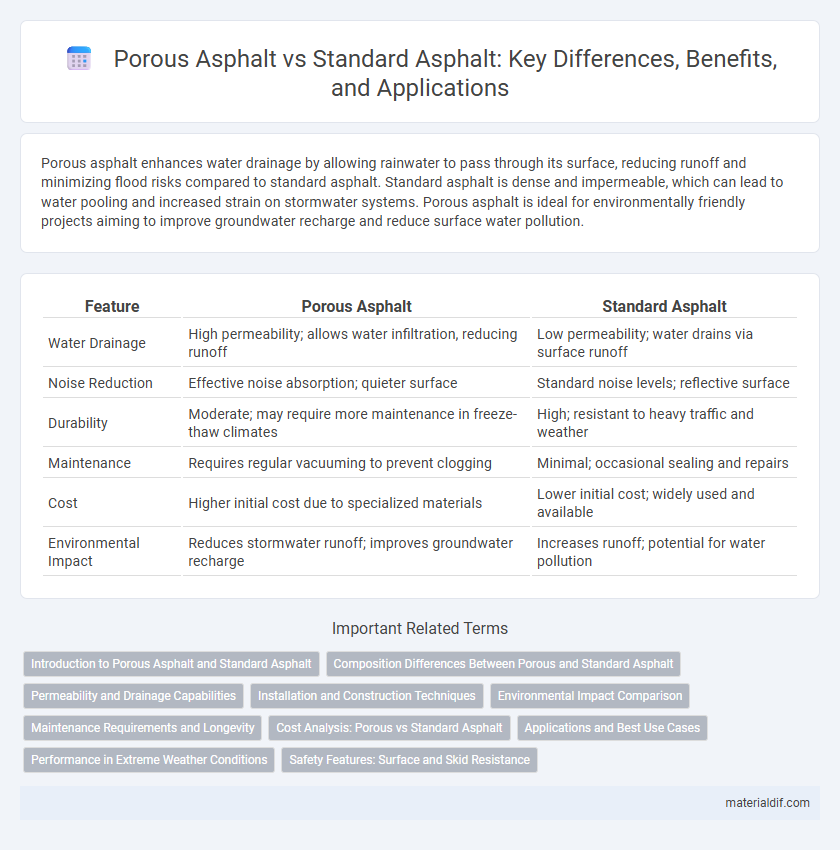Porous asphalt enhances water drainage by allowing rainwater to pass through its surface, reducing runoff and minimizing flood risks compared to standard asphalt. Standard asphalt is dense and impermeable, which can lead to water pooling and increased strain on stormwater systems. Porous asphalt is ideal for environmentally friendly projects aiming to improve groundwater recharge and reduce surface water pollution.
Table of Comparison
| Feature | Porous Asphalt | Standard Asphalt |
|---|---|---|
| Water Drainage | High permeability; allows water infiltration, reducing runoff | Low permeability; water drains via surface runoff |
| Noise Reduction | Effective noise absorption; quieter surface | Standard noise levels; reflective surface |
| Durability | Moderate; may require more maintenance in freeze-thaw climates | High; resistant to heavy traffic and weather |
| Maintenance | Requires regular vacuuming to prevent clogging | Minimal; occasional sealing and repairs |
| Cost | Higher initial cost due to specialized materials | Lower initial cost; widely used and available |
| Environmental Impact | Reduces stormwater runoff; improves groundwater recharge | Increases runoff; potential for water pollution |
Introduction to Porous Asphalt and Standard Asphalt
Porous asphalt features a permeable structure that allows water to drain through its layers, reducing surface runoff and improving stormwater management. Standard asphalt, composed of dense aggregates and bitumen, forms a solid, impermeable surface that effectively supports heavy traffic but does not facilitate water infiltration. Comparing their uses, porous asphalt is ideal for parking lots and low-traffic areas requiring drainage, while standard asphalt suits highways and high-traffic roads demanding durability.
Composition Differences Between Porous and Standard Asphalt
Porous asphalt consists of a high void content mixture with coarse aggregates and minimal fine materials, allowing water to drain through its surface, unlike standard asphalt which includes a denser blend of fine and coarse aggregates held together by asphalt binder to create a solid, impermeable pavement. The composition of porous asphalt prioritizes air voids ranging from 15% to 20%, optimized for permeability, whereas standard asphalt typically has less than 5% voids to maximize durability and load-bearing capacity. These compositional differences directly influence their respective functionalities in stormwater management and structural performance.
Permeability and Drainage Capabilities
Porous asphalt features a high permeability rate, enabling water to quickly pass through its interconnected voids, significantly enhancing drainage capabilities compared to standard asphalt. Standard asphalt typically has low permeability, causing water to accumulate on the surface, increasing the risk of hydroplaning and pavement deterioration. The improved drainage of porous asphalt reduces surface runoff, mitigates flooding, and promotes safer driving conditions in areas with heavy rainfall.
Installation and Construction Techniques
Porous asphalt requires specialized installation techniques involving precise grading for effective water drainage and the use of open-graded aggregates that facilitate permeability. Standard asphalt employs conventional paving methods with a dense-graded mixture designed for durability and smoothness, relying on compaction to create a watertight surface. The construction of porous asphalt demands careful attention to layer thickness and base material permeability to maintain structural integrity and optimize stormwater management.
Environmental Impact Comparison
Porous asphalt significantly reduces stormwater runoff by allowing water to infiltrate through its surface, which decreases the risk of flooding and recharges groundwater. Standard asphalt, being impermeable, contributes to increased surface runoff, leading to pollutants being washed into nearby waterways. The use of porous asphalt also mitigates urban heat island effects by enhancing evaporative cooling, making it a more environmentally sustainable choice.
Maintenance Requirements and Longevity
Porous asphalt requires frequent inspection and maintenance to ensure clog-free permeability, including regular vacuuming or pressure washing to prevent debris buildup, whereas standard asphalt demands less frequent but more intensive repairs such as crack sealing and resurfacing. Longevity of porous asphalt typically ranges from 10 to 20 years, influenced by environmental conditions and maintenance, while standard asphalt can last 15 to 25 years with proper upkeep due to its denser, less permeable structure. Effective maintenance strategies directly impact the lifespan and performance of both asphalt types, with porous asphalt needing more consistent attention to sustain drainage capabilities.
Cost Analysis: Porous vs Standard Asphalt
Porous asphalt typically incurs higher initial installation costs than standard asphalt due to specialized materials and construction techniques required for effective drainage. Maintenance expenses for porous asphalt can be variable, often balancing out over time with reduced stormwater management costs and potential regulatory savings. Standard asphalt generally presents lower upfront costs but may necessitate additional investment in drainage infrastructure and increased long-term maintenance due to water damage.
Applications and Best Use Cases
Porous asphalt is ideal for applications requiring enhanced stormwater management, such as parking lots, low-traffic roads, and pedestrian pathways, due to its permeability that allows water to drain through the pavement surface. Standard asphalt excels in high-traffic areas like highways, city streets, and airport runways by providing durable, smooth surfaces with superior load-bearing capacity. Choosing porous asphalt is best for sustainable urban drainage projects, while standard asphalt suits heavy-duty infrastructure demanding long-lasting performance.
Performance in Extreme Weather Conditions
Porous asphalt excels in extreme weather conditions by efficiently managing water drainage and reducing surface water accumulation, which minimizes hydroplaning and ice formation risks. Standard asphalt, while durable, often retains water on the surface, leading to increased slipperiness and faster deterioration in freeze-thaw cycles. The permeability of porous asphalt supports faster drying and enhanced skid resistance, improving safety and longevity in harsh climates.
Safety Features: Surface and Skid Resistance
Porous asphalt enhances safety by improving surface water infiltration, reducing hydroplaning risks through superior drainage compared to standard asphalt. The open-graded structure of porous asphalt increases skid resistance, providing better traction under wet conditions. Standard asphalt offers less permeability, which can lead to water accumulation and decreased skid performance on wet surfaces.
Porous Asphalt vs Standard Asphalt Infographic

 materialdif.com
materialdif.com